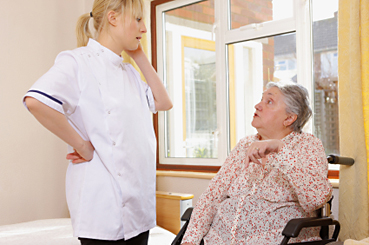
Incontinence is one of long-term care’s most difficult—and prevalent—challenges to address. A majority of residents will present needs for incontinence care—a difficult circumstance that is not made easier if there is high staff turnover or insufficient education. Incontinence care demands attention continually, as experts on this subject advise below.
1
Providers should not take for granted that incontinence is an inevitability.
“Residents in the early stages of incontinent behavior may appear to be headed toward a future of wearing incontinence garments,” observes Kathie Vick, marketing manager for RF Technologies. “However, the need can be delayed or averted by beginning a bladder training routine as soon as symptoms manifest themselves.”
2
Incontinence care also can involve more than pads and products.
“Technology can be a valuable tool for caregivers interested in instituting bladder and bowel programs,” Vick says. “By using an ‘event scheduling’ program, as is available on current integrated care management systems, caregivers can add scheduled bathroom trips to a resident’s daily routine.”
These trips can be of expanding length, depending upon how successful a bladder training routine might be.
3
Taking technology a step further, wireless technology can provide nurses who are on the move with automated reminders.
They can arrive “on cell phones and pagers, regardless of where the caregiver is located in the community.
Likewise, wireless incontinence detection technology can be used to alert caregivers of an incontinence event, regardless of the location of the resident,” Vick explains. “Point-of-care recording technology allows caregivers to enter urination and leakage episodes right away, so that all episodes are recorded and factored into decision making and care records.”
4
Incontinence should never be taken lightly; it can have many ripple effects.
“Incontinence is major concern that impacts wound healing,” notes Greg Bila, group marketing manager for Kinetic Concepts Inc. Things like the company’s V.A.C. Therapy, as well as low-air loss surfaces that reduce pressure, allow blood flow and promote healing, he added.
5
“The most important step to promote continence is to first consider that managing incontinence is much more than just checking and changing the residents every two hours!” emphasizes Amin Setoodeh, BSN, RN, vice president, Personal Care Division, Medline Industries. “(But) discourage replacing toileting with usage of absorbent incontinent products.
“It is imperative that the entire [caregiving] team embraces the notion of promoting continence by working together and to use a systematic approach.”
This includes conducting a complete bowel and bladder assessment upon admission or whenever there is a significant change of condition.
6
Consider various strategies to deal with incontinence obligations, especially when staff might feel overwhelmed.
For example, you could develop an incontinence/restorative care team to take the lead, Setoodeh says. Or request a urological consultation to conduct the Bowel & Bladder assessment.
“Promote communication with the attending physician, pharmacist and clinical team to review medications and potential impact on episodes of incontinence,” he adds.
A physical therapist could be utilized to support efforts with behavioral treatments.
7
Small steps can be the key. When facing a large incontinence care workload, providers could start by focusing on a few residents on the same floor, Setoodeh says. “Set short-term and measurable objectives for your staff to promote a sense of accomplishment,” he adds.
8
“Lastly, become a leader for your team by adopting the mission of promoting continence as one of your core values for every resident who experiences incontinence in your facility,” Setoodeh urges. “
_____
Mistakes to avoid
-Resigning yourself to treating all new admissions automatically with briefs or underpads
-Not consulting other team members or clinicians for treatment options
-Ignoring new technology options for incontinence care
From the July 01, 2010 Issue of McKnight's Long-Term Care News




